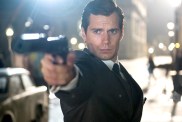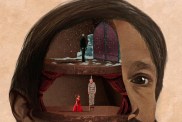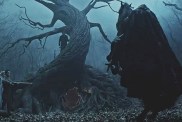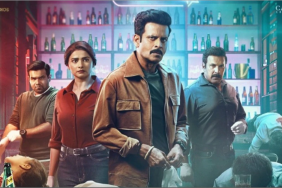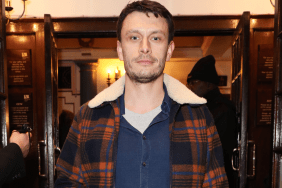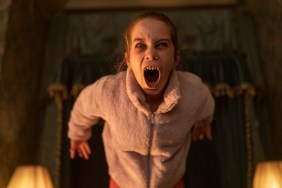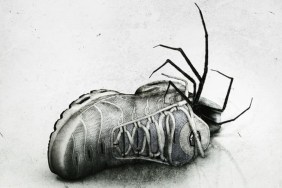
From the opening involving a group of strangers on a plane to the appropriately titled “Road to Hell” about road rage gone wrong to “Til Death To Us Part” about the most horrifying ever, it’s an absolutely hilarious and slightly deranged movie that’s been winning over audiences wherever it’s played. Argentina even made it their selection for the Academy Awards, becoming the seventh film from that country to join the exclusive list of Foreign Language nominees.
ComingSoon.net sat down with Szifron when he was in New York to talk about the film that’s been leaving such a lasting impression on everyone who sees it.
The interview started in an unusual way in that Szifron noticed the T-shirt I was wearing from Roger Waters’ The Wall show from Yankee Stadium a few years back leading to the director ruminating on some of the influences for Wild Tales before we even got to our first question.
Damián Szifron: I like your shirt and you know, I thought a lot of that album while making this film.
ComingSoon.net: You’re going to have to explain that, because I would have never made that connection when I threw on this shirt this morning.
Szifron: Yeah, yeah. But when I looked for references, they were not in the cinema or not only in the cinema, more literature anthologies and concept rock albums. You have different tracks, but they’re all connected, they’re all linked. Different songs—one is two minutes, the other one is much longer—and it works as a single experience.
CS: Was the concept what came to you first?
Szifron: No, the stories. The stories came first. I was developing other films—a science fiction trilogy, a love story, a Western—and I have a lot of stuff in development , so to the new ideas that kept on coming, it was a very expansive and creative period of time. I tried to compress them to stop from becoming more feature films, and as a result, I got these powerful short stories, and they made me a freer writer, because in one night I could write a story or I would be on the road and have a discussion with another driver and then he went away very fast. So I started imagining what if a few miles ahead, this guy has a flat tire and if instead of me, I have this huge guy driving this car and he finds the *sshole a few miles ahead and can take revenge. So I would stop in the middle of the desert to write this story, like a musician that wakes up and creates a song and then the next morning, he’s working on another song. You don’t do that as a writer. You have to live for months with the same story/characters/universe. When I had three or four stories already written, I discovered that the themes were connecting the whole thing, and they all came from the same DNA, and I said okay, “There’s a concept here and the stories.”
CS: Anthologies aren’t done very much. When they’re done as movies, they’re usually done with different directors and writers exploring the same themes to form something overall. In theory, you could have made these all as short films or as a TV show like “Outer Limits.”
Szifron: Absolutely, and those were the references as well. The TV shows like “Alfred Hitchcock Presents,” “Amazing Stories”…

CS: So at what point do you decide you’re just going to do it as six short stories within one movie that are all connected? Because another option would have been to have an actual connection between them.
Szifron: Absolutely, like “Pulp Fiction,” you have a character that comes from one story and enters the other one, yes. This is the way that “Wild Tales” came to me and I tried to keep close to that essence. At a moment, I said, “Okay, perhaps this is not what the audience expects or the producers want, etc. etc.” But I saw the film and I saw it working. I always imagine through desire, not through fear. I think in favor of what I’m writing, not as a devil’s advocate. “No, it’s not going to work.” I say, “Why not? Why not?” Of course, I thought of the circus for example. You go to the circus and then you have the guy with the lions and that works because of the courage of getting inside a cage with fierce animals. And then you have the magician and you like that because of the suspense. “How is he doing that?” And then you have the clown and then you laugh, and you laugh. So you like them as different short numbers for different reasons, but they all work in the context of a single experience and that can be translated to a form of filmmaking.
CS: I think the most interesting films are the ones that offer different experiences, where they’re not just a straight comedy trying to get laughs. When you’re trying to get laughs for 90 minutes to 2 hours, it doesn’t always work, just the same as if you have a drama that doesn’t offer some sort of levity, you’ll just get depressed by it.
Szifron: Life is a mix of drama, comedy, action. You have all that in your life, so yes, when you can express that through a cinematic experience, I think people can relate to it. There is something about this that I feel, I see. That belongs to me or I belong to that, and the film is connecting with audiences from all over the world.
CS: I don’t want to talk too much in detail about any of the stories, because what’s fun about the movie are the surprises by how far things go.
Szifron: Yes, yes, I agree. Thank you, thank you.
CS: Even with the opening sequence on the plane, if you’re on board—sorry for the pun—with that first scene, then you kind of know what you’re in for. Was that opening scene something you came up with early on?
Szifron: Yes, and that’s the difference with the rest of the short stories I would say. The order is the exact order in which I wrote the stories. It’s not that I wanted to keep the order. I forgot about it and tried different ones, and then I decided on this one and then after releasing, I thought, “Okay, this is how I wrote it” so at a subconscious level I thought that when I was interested in one particular story, that was because it came after the one that I wrote before. There was kind of an evolution. It’s not that each one has to be louder or something, but you need progression and variation, those things that I think in a film like this, they are useful.

CS: When you started to shoot the films, did you have any idea in which order you wanted to shoot them? Some are more location based then other ones, obviously.
Szifron: In the script, I wrote them separately and then I put them together and I had a script. The order was the same with the difference was that the engineer with the explosives, that was at the end and the wedding one was in the middle. But the wedding one has a different ending—it ended before with the parademics taking the bride in a stretcher as everything was collapsing. I didn’t have that final turn, but then while directing the actors during the wedding, I discovered, “No, there’s more here. What’s going on?” I felt like it keeps on going and that we could go further than this. So when we closed that circle, I knew that had to be at the end, but that was the last story I wrote. When I put that at the end, the natural order rose.
CS: This would be a funny date movie because if you both feel the same way whether you both love it or hate it, you’re probably made for each other… especially if you get to the wedding sequence at the end and agree on that.
Szifron: (laughs) You’re right, you’re right. Absolutely, I agree.
CS: I’ve warned friends who are getting married not to see this movie until after the wedding. Let’s talk about the cast, because Ricardo Marin is an actor we know very well here, at least anyone who has seen any films from Argentina. Did you know some of the actors from your previous work in television or was it all new people you cast for the roles?
Szifron: No, the only actress that I worked with before is the bride, Erika. The rest, I know them all, I admire them all, and I wanted to work with great actors and stage actors, so as soon as I decided on this project, the nature of it allowed me to call people that don’t usually work together, because each one is the main character of their film in this case. Another asset of a project of this nature is that I needed them for eight or ten days, not for three months, so they could (make it work). As soon as they were ready and immediately on board in a joyful way, they liked to be together with the rest of the cast. Of course, Ricardo, he’s the main actor in Argentina. He’s very loved by the people and respected.
CS: What’s the film environment like in Argentina? I feel like there’s a lot of films coming out of there, but it still feels very enclosed and difficult for movies made there to be seen elsewhere.
Szifron: Yes, there’s a lot of films being made and very few travel, and most of the ones that travel are arthouse films that go to festivals, and you can probably look at them at the MOMA but you won’t see them in a regular theater. Then you have mainstream films that are for big audiences but they are sometimes kind of stupid or very manufactured pieces of entertainment. You don’t feel the presence of art there in any way.
CS: We have a lot of that here, too, so that’s not that unusual.
Szifron: I know, I know, but you have your own stuff. You don’t have to bring things from Argentina. The movies that I like as a moviegoer—I’ve gone to the movies since I was zero. My father was this huge cinephile so he used to take me. The ones that I loved, they are kind of in the middle. You can’t tell if they are art or spectacle. Is spectacle the right word?
CS: Usually, we think of “spectacle” as a blockbuster with a big budget…
Szifron: Okay, okay, no, I like “The Godfather.” It’s elevated art but at the same time, a lot of people go to see it. It’s popular art, and I think that movies have that, they’re popular art. I like that.

CS: I’d say maybe something like David Fincher’s “Gone Girl” could be considered popular art.
Szifron: I agree.
CS: We talked briefly about not having a connection between the stories, but you mentioned shows that had a link in the person introducing them, like with Rod Serling on “The Twilight Zone.”
Szifron: Yes, yes. I thought of everything, but I thought of everything because of fear, not because of desire. When I would say to somebody that I’m working on this anthology, and they would go, “And then all the characters get together at the end?” “No.” “And you have one character coming out from the story and entering the other?” “No.” So at a point I said, “Okay, perhaps I should find this way to connect the stories,” so I thought of a bird flying all over the scenarios and to have a character that’s a writer in one of the stories and suddenly, you see a sketchbook and everything’s there so everything’s part of his imagination. I thought of a lot of things in connecting them. Having a main character as a secondary character in another story, etc. But in the end, I thought that it’s been done so many times. You have great films that work like that. You have bad films that are like that. I thought this is more original. The original idea is fresher, and I truly like the diversity and the cuts. I like to cut from a film that’s in the desert to another one that’s in the city and from one that’s at night with the rain and then cut to the sun. I like that.
CS: Do you have any more ideas for future Wild Tales? Has that ball started rolling yet to do a sequel made up of more shorts?
Szifron: Yeah, I thought of a title. It could be called “More Tales, More Wild.” Something like that. I like the anthology form and I could do another. It’s not what I’m doing next, that’s for sure, but as I told you before, I enjoyed the freedom while writing short stories during the night. I liked that, so I’m still writing short stories all the time, not only wild ones. I would like to make other anthologies as well. I actually love the science fiction genre.
CS: You mention having other things you were working on before, so now that more attention’s been drawn to your work, have you thought about doing some of those in English with American or British actors?
Szifron: Yeah, I received a lot of invitations to work here, and they sent me some scripts and some books, and also some invitations from very important producers to make my own work here. I would say that everything is very open right now, and I’m going to spend some time, a month or two, thinking about what is the next step. But it could be an American film, it could be.
CS: Knowing that this movie will bring more attention to Argentina, is it hard to step away from that when you could stay there and maybe work at a lower budget but have more freedom? You have this momentum right now and you could help the Argentinian industry by staying there to make movies.
Szifron: Absolutely, yes, yes, of course. I don’t know. I think that everything is so connected right now. You can make a film here that goes all over the place or make a co-production between Europe and Argentina. I like film and I like fiction. It’s not that I’m so fond of nationalities, and I think we human beings are connected by things that are much stronger and deeper than nationality, which is our DNA. We’ll laugh at the same things. We’re scared of the same things. We come from the same monkeys, and filmmaking makes that very clear. A theater full of people from different countries like Cannes laughing at the same thing, it makes you feel closer, so I like that. I don’t know where the money comes from or in which language they speak, that I don’t know yet.
Wild Tales opens in New York and Los Angeles on Friday, February 20.
Wild Tales
-
Wild Tales 01

-
Wild Tales 02

-
OLYMPUS DIGITAL CAMERA

OLYMPUS DIGITAL CAMERA -
OLYMPUS DIGITAL CAMERA

OLYMPUS DIGITAL CAMERA -
Wild Tales 05

-
Wild Tales 06

-
Wild Tales 07

-
Wild Tales 08

-
Wild Tales 09

-
Wild Tales 10

-
Wild Tales 11

-
Wild Tales 12

-
Wild Tales 13

-
Wild Tales 14

-
Wild Tales 15

-
Wild Tales 16

-
Wild Tales 17

-
Wild Tales 18

-
Wild Tales 19

-
Wild Tales 20

-
Wild Tales 21

-
Wild Tales 22

-
Wild Tales 23

-
Wild Tales 24

